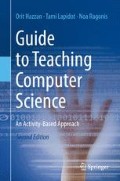Abstract
This chapter presents active-learning-based teaching methods that computer science educators can employ in the classroom. The purpose of this chapter is first, to let the students in the Methods of Teaching Computer Science (MTCS) course experience a variety of teaching methods before becoming computer science teachers; second, to discuss, together with the students, the advantages and disadvantages of these teaching methods; and third, to demonstrate high school teaching situations in which it is appropriate to employ these teaching methods. Within this chapter, we discuss (a) pedagogical tools: games, the CS-unplugged approach, rich tasks, concept maps, classification, and metaphors; (b) different forms of class organization; and (c) mentoring software project development.
Access this chapter
Tax calculation will be finalised at checkout
Purchases are for personal use only
Notes
- 1.
- 2.
©Hebetim (2005).
- 3.
Due to space limitations, only part of the topics addressed in the MTCS course are included in the map.
- 4.
Sometimes, different kinds of shapes and arrows are used to indicate different kinds of concepts and different types of relations among them. For the sake of simplicity, we decided to use the same shape (rectangle) for all concepts and the same kind of arrow for all types of relationships between them.
- 5.
Resources of the items included in the control structure classification worksheet (Fig. 7.3): Item #3 http://homes.bio.psu.edu/people/faculty/bshapiro/research.html. Item #4 http://www.chicago-l.org/operations/lines/loop.html. Item#5 http://www.quiltdesignnw.com/Q132-SimplySunny-Easy-Kaleidoscope-Flower-quilt-pattern.htm. Item #8 http://www.junewatts.com/wwwcd.htm. Item #9 http://vanelsas.wordpress.com/2009/04/03/questions/. Items #10 and #12 Lyrics from Mother Goose. Item #13 Article 11 of the Universal Declaration of Human Rights of the General Assembly of the United Nations, formulated on December 10, 1948: http://www.un.org/en/documents/udhr/. Item #14 http://www.redbubble.com/people/taniadonald/t-shirts/1340952-3-if-youare-close-enough-to-read-this-you-can-blow-me. Item #15 http://www.allbusinessrecords.com/projects.html.
- 6.
References
Barak M, Waks S, Doppelt Y (2000) Majoring in technology studies at high school and fostering learning. Learn Environ Res An Int J 3:135–158
Blumenfeld PC, Soloway E, Marx R et al (1991) Motivating project-based learning: sustaining the doing, supporting the learning. Educ Psychol 26:369–398
Boticki I, Barisic A, Martin S, Drljevic N (2013) Teaching and learning computer science sorting algorithms with mobile devices: a case study. Comput Appl Eng Educ 21:E41–E50. doi:10.1002/cae.21561. http://onlinelibrary.wiley.com/doi/10.1002/cae.21561/abstract
Eidelman L, Hazzan O, Lapidot T, Matias Y, Raijman D, Segalov M (2011) Can a 2-hour visit to a hi-tech company increase interest in and change perceptions about computer science? ACM Inroads mag 2(3):64–70
Ernest P (1995) The one and the many. In: Steffe LP, Gale J (Eds) Constructivism in education. Lawrence Erlbaum Associates, Hillsdale, pp 459–486
Fincher S, Petre M (1998) Project-based learning practices in computer science education. Proc Front Educ Conf, Tempe Arizona:453–494
Green AM (1998) Project-based learning: Moving students through the GED with meaningful learning. ERIC Database, ED422466
Hebetim (1995) Educational game—the Conditional-Statement-Bingo, Hebetim—Journal of the Israeli National Center for Computer Science Teachers, June:31–32
Johnson DS (1997) Learning technological concepts and developing intellectual skills. Int J Technol Des Educ 7:161–180
Kay J, Barg M, Fekete A et al (2000) Problem-based learning for foundation Computer Science courses. Comput Sci Educ 10:109–128
Krajcik JS, Blumenfeld PC, Marx RW et al (1998) Inquiry in project-based science classrooms: Initial attempts by middle school students. J Learn Sci 7:313–350
Krajcik JS, Czerniak C, Berger C (1999) Teaching science: A project- based approach. McGraw Hill College, New York
Lakanen A, Isomöttönen V, Lappalainen V (2014) Five years of game programming outreach: Understanding student differences. Proceedings of SIGCSE 2014—The 45th ACM Technical Sym on Comp Science Edu, Atlanta, GA, USA: 647–652
Lakoff G, Johnson M (1980) Metaphors we live by. The University of Chicago Press, Chicago IL
Lapidot T, Levy D (1993) From programming to computer science: Opportunities and pitfalls. In: Kynigos C (ed) Proceedings of the 4th Euro-Par conference. Logo conf, Athens
Levy D, Lapidot T (1997) Rich task: Opportunities for learning computer science ideas. Hebetim—J Israeli Natl Cent for Comput Sci Teach 9:34–26
Meerbaum-Salant O, Hazzan O (2008) Challenges in mentoring software development projects in the high school: analysis according to Shulman’s teacher knowledge base model. J Comput Math Sci Teach 28(1):23–43
Meerbaum–Salant O, Hazzan O (2010) An agile constructionist mentoring methodology for software projects in the high school, ACM Transactions on Computing Education—TOCE 9(4), Article 21:1–29
Novak J D, Cañas A J (2008) The theory underlying concept maps and how to construct them, Technical Report IHMC CmapTools 2006 – 01 Rev 01–2008, Florida Inst. for Hum. and Mach. Cogn. http://cmap.ihmc.us/Publications/ResearchPapers/TheoryUnderlyingConceptMaps.pdf. Accessed 14 July 2010
Shepherd H G (1998) The probe method: a project-based-learning model’s effect on critical thinking skills. Diss Abstr Int Sect A 59(3 A):779
Thomas J W (2000) A review of research on project-based learning. http://www.autodesk.com/foundation.
Waks S (1997) Education and technology-dimensions and implications. Position paper on prospects of interrelationship between the academia and the educational system in Israel, the Van Leer Jerusalem Institute, The Forum for High. Educ., the Ministry of Education, Culture and Sports, Israel
Warren J, Rixner S, Greiner J, Wong S (2014) Facilitating human interaction in an online programming course. Proceedings of SIGCSE 2014—The 45th ACM Technical Sym on Comp Science Edu, Atlanta, GA, USA, 665–670
Williams L, Kessler R (2002) Pair programming illuminated. Addison Wesley, Boston
Author information
Authors and Affiliations
Corresponding author
Rights and permissions
Copyright information
© 2014 Springer-Verlag London Limited
About this chapter
Cite this chapter
Hazzan, O., Lapidot, T., Ragonis, N. (2014). Teaching Methods in Computer Science Education. In: Guide to Teaching Computer Science. Springer, London. https://doi.org/10.1007/978-1-4471-6630-6_7
Download citation
DOI: https://doi.org/10.1007/978-1-4471-6630-6_7
Published:
Publisher Name: Springer, London
Print ISBN: 978-1-4471-6629-0
Online ISBN: 978-1-4471-6630-6
eBook Packages: Computer ScienceComputer Science (R0)

